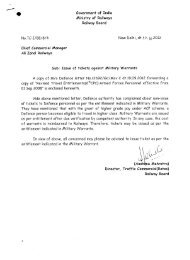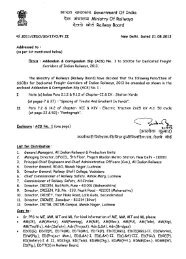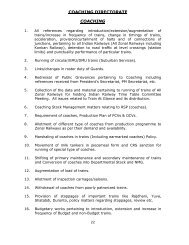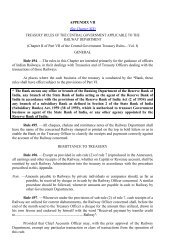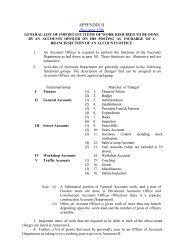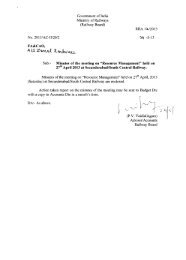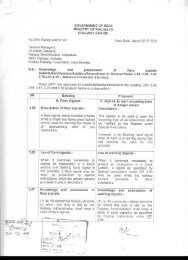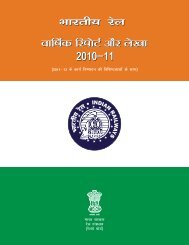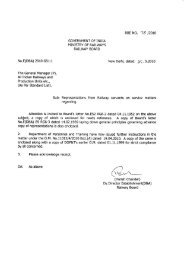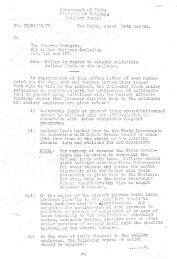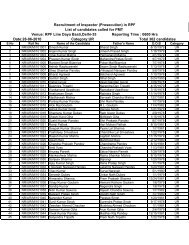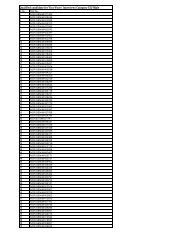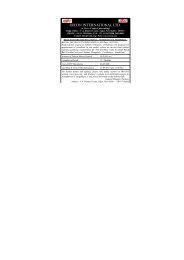G&SR 216 CHAPTER IX THE AUTOMATIC BLOCK ... - Indian Railway
G&SR 216 CHAPTER IX THE AUTOMATIC BLOCK ... - Indian Railway
G&SR 216 CHAPTER IX THE AUTOMATIC BLOCK ... - Indian Railway
You also want an ePaper? Increase the reach of your titles
YUMPU automatically turns print PDFs into web optimized ePapers that Google loves.
<strong>CHAPTER</strong> <strong>IX</strong><br />
<strong>THE</strong> <strong>AUTOMATIC</strong> <strong>BLOCK</strong> SYSTEM<br />
A. Rules applicable to Double Line<br />
9.01 Essentials of the Automatic Block System on double line––<br />
(1)Where trains on a double line are worked on the Automatic Block<br />
system<br />
(a) the line shall be provided with continuous track circuiting or<br />
axle counters,<br />
(b) the line between two adjacent block stations may, when<br />
required, be divided into a series of automatic block signalling<br />
sections, each of which is the portion of the running line<br />
between two consecutive Stop signals and the entry into each of<br />
which is governed by a Stop signal, and<br />
(c) the track circuits or axle counters shall so control the Stop<br />
signal governing the entry into an automatic block signalling<br />
section that -<br />
(i) the signal shall not assume an `off` aspect unless the line is<br />
clear not only up to the next Stop signal in advance but also<br />
for an adequate distance beyond it and<br />
(ii) the signal is automatically placed to `on` as soon as it is<br />
passed by the train.<br />
(2) Unless otherwise directed by approved special instructions, the<br />
adequate distance referred to in sub-clause (i) of clause (c) of<br />
sub-rule (1) shall not be less than 120 metres<br />
S.R. 9.01.1. The Automatic Block System is in force on certain sections of<br />
Secunderabad, Hyderabad and Vijayawada divisions (See S.R. 7.01.1).<br />
2. A T<strong>SR</strong> shall be maintained by the Station Master of each reporting station and<br />
detailed timings of all the trains dealt with shall be recorded therein, detailed procedure<br />
for advising the reporting station regarding the train number and the timings shall be<br />
incorporated in the SWR.<br />
3. All Guards/Loco Pilots/Motormen/Assistant Loco Pilots working on the Automatic<br />
Block System shall be thoroughly examined in their knowledge of rules for working of<br />
trains in Automatic Block System and there upon shall be issued with a competency<br />
certificate after having undergone the orientation course for Guards/Loco<br />
Pilots/Motormen/Assistant Loco Pilots at the nominated training centers/Institute and<br />
they shall not be allowed to work on such section unless they are in possession of such<br />
certificates.<br />
All Guards, Loco Pilots, Motormen, Assistant Loco Pilots, who are required to<br />
work on automatic signalling sections, shall be imparted one day intensive course, once<br />
in every six months, about the rules pertaining to this system and competency<br />
certificates issued/renewed in token of their knowledge and proficiency in these rules. A<br />
record of such competency certificates issued shall be maintained by the DSO, DME<br />
and DEE concerned. No Guard, Loco Pilot, Motorman, Assistant Loco Pilot shall be put<br />
on duty on Automatic section unless he possess such certificate.<br />
Note: (i) Principal/ZRTI/MLY issues competency certificate whenever Guards,<br />
Loco Pilots and Assistant Loco Pilots attend Initial/Refresher training course at<br />
ZRTI/MLY.<br />
G&<strong>SR</strong> <strong>216</strong>
(ii) Traffic Inspectors and Loco Inspectors renew competency certificates once in<br />
six months after imparting one day’s intensive training till the next refresher<br />
course.<br />
<strong>THE</strong> <strong>AUTOMATIC</strong> <strong>BLOCK</strong> SYSTEM<br />
________________________________________________________________<br />
9.02 Duties of Loco Pilot and Guard when an Automatic Stop signal on<br />
double line is to be passed at ‘on’––<br />
(1) when a Loco Pilot finds an Automatic Stop signal with an `A`<br />
maker at `on`, he shall bring his train to a stop in the rear of the<br />
signal. After bringing his train to a stop in the rear of the signal, the<br />
Loco Pilot shall wait there for one minute by day and two minutes<br />
by night. If after waiting for this period, the signal continues to<br />
remain at `on`, he shall give the prescribed code of whistle and<br />
exchange signals with the Guard and then proceed ahead, as far as<br />
the line is clear, towards the next Stop signal in advance exercising<br />
great caution so as to stop short of any obstruction.<br />
(2) The Guard shall show a Stop hand signal towards the rear when the<br />
train has been so stopped at an Automatic Stop signal, except as<br />
provided for in sub-rule (4)<br />
(3) Where owing to the curvature of the line, fog, rain or dust storm,<br />
engine working the train pushing it or other causes, the line ahead<br />
cannot be seen clearly, the Loco Pilot shall proceed at a very slow<br />
speed, which shall under no circumstances exceed 8 kilometres an<br />
hour. Under these circumstances, the Loco Pilot, when not<br />
accompanied by an Assistant Loco Pilot and if he considers<br />
necessary, may seek the assistance of the Guard by giving the<br />
prescribed code of whistle<br />
(4) When so sent for by the Loco Pilot, the Guard shall accompany him<br />
on the engine cab, before he moves forward, to assist the Loco<br />
Pilot in keeping a sharp look-out.<br />
(5) When an Automatic Stop signal has been passed at ‘on’, the Loco<br />
Pilot shall proceed with great caution until the next Stop signal is<br />
reached. Even if this signal is ‘off’, the Loco Pilot shall continue to<br />
look out for any possible obstruction short of the same. He shall<br />
proceed cautiously up to that signal and shall act upon its<br />
indication only after he has reached it.<br />
S.R. 9.02 1. The ‘on’ position of an Automatic Stop signal may be due to the presence<br />
of a train in the Automatic Signalling section ahead or due to an obstruction on the track<br />
or a broken or a displaced rail or any other cause.<br />
When a Loco Pilot passes an Automatic Stop signal at ‘on’ he shall proceed at a speed<br />
not exceeding 10 KMPH to enable him to stop short of any obstruction. He shall continue<br />
to drive cautiously at this speed until he passes the next Stop signal. The speed shall be<br />
further restricted to 8 KMPH during poor visibility due to curvature of the line, fog, duststorm,<br />
engine working the train pushing it or any other cause.<br />
2. When it becomes necessary to stop a train in rear of an Automatic Stop signal at ‘on’<br />
it shall be brought to a stop as close as possible in rear of that Automatic Stop signal so<br />
as to provide the maximum possible margin for the Loco Pilot of a following train, driven<br />
cautiously, to stop clear of the train ahead.<br />
3. The indication of an Automatic Stop signal applies only to the track beyond the signal<br />
and there is a possibility of a train standing in rear of the signal while it is showing `off` A<br />
Loco Pilot having passed an Automatic Stop signal at ‘on’ shall not, therefore, act on the<br />
indication of the signal ahead until he has actually reached it.<br />
G&<strong>SR</strong> 217
4. Distance between two trains in Automatic signalling territories after passing an<br />
Automatic Stop signal at ‘on’-<br />
<strong>THE</strong> <strong>AUTOMATIC</strong> <strong>BLOCK</strong> SYSTEM<br />
________________________________________________________________<br />
After passing an Automatic Stop signal at ‘on’, the Loco Pilot of the following train<br />
hauled by any locomotive, shall ensure that a minimum distance of 150 metres or two<br />
clear OHE spans (on electrified sections) is maintained between his train and the<br />
preceding train or any obstruction on the line.<br />
However, the above distance may be reduced to 75 metres or one clear OHE span<br />
in case of EMU train following. In special circumstances like floods etc., the following<br />
train may be drawn closer to the preceding train or the obstruction.<br />
5. After passing an Automatic Stop signal at ‘on’, the Guard of a train shall watch that<br />
the Loco Pilot does not exceed the speed prescribed in S.R. 9.02.1. If the Loco Pilot<br />
exceeds the speed prescribed, the Guard shall take action as per G.R. 4.45.<br />
Note –– Also see S.R. 3.74.<br />
B. Rules applicable to Single Line<br />
9.03 Essentials of the Automatic Block System on single line––<br />
(1) Where trains on a single line are worked on the Automatic Block<br />
System<br />
(a) the line shall be provided with continuous track circuiting or<br />
axle counters,<br />
(b) the direction of traffic shall be established only after Line Clear<br />
has been obtained from the block station in advance,<br />
(c) a train shall be started from one block station to another only<br />
after the direction of traffic has been established,<br />
(d) it shall not be possible to obtain Line Clear unless the line is<br />
clear, at the block station from which Line Clear is obtained, not<br />
only up to the first Stop signal but also for an adequate distance<br />
beyond it.<br />
(e) the line between two adjacent block stations may, where<br />
required, be divided into two or more automatic block signalling<br />
sections by provision of Stop signals,<br />
(f) after the direction of traffic has been established, movement of<br />
trains into, through and out of each automatic block signalling<br />
section shall be controlled by the concerned Automatic Stop<br />
signal and the said Automatic Stop signal shall not assume ‘off’<br />
position unless the line is clear up to the next Automatic Stop<br />
signal<br />
provided further that where the next Stop signal is a Manual<br />
Stop signal, the line is clear for an adequate distance beyond it,<br />
and<br />
(g) all Stop signals against the direction of traffic shall be at ‘on’.<br />
(2) Unless otherwise directed by approved special instructions, the<br />
adequate distance referred to in clauses (d) and (f) of sub-rule (1)<br />
shall not be less than 180 metres.<br />
S.R.9.03.1. The Automatic Block System on single line is in force on the twin single lines<br />
between Vijayawada junction and Krishna Canal junction on this <strong>Railway</strong> using axle<br />
counters over the two Krishna Bridges and track circuiting on the remaining portions of<br />
G&<strong>SR</strong> 218
the lines. Detailed instructions for working of traffic on this section shall be incorporated<br />
in the SWR of Vijayawada junction and Krishna Canal junction stations.<br />
2. The resetting of axle counters shall be done by a responsible official of the rank not<br />
less than that of a Signal Inspector and CASM on duty.<br />
<strong>THE</strong> <strong>AUTOMATIC</strong> <strong>BLOCK</strong> SYSTEM<br />
________________________________________________________________<br />
3. A T<strong>SR</strong> shall be maintained by the Station Master and detailed timings of all the trains<br />
dealt with shall be recorded therein.<br />
9.04 Minimum equipment of fixed signals in Automatic Block territory on<br />
single line––<br />
The minimum equipment of fixed signals to be provided for each direction<br />
shall be as follows––<br />
(a) Manual Stop signals at a station -<br />
(i) a Home,<br />
(ii) a Starter,<br />
(b) An Automatic Stop signal in rear of the Home signal of the station.<br />
Note –– Under approved special Instructions, the Automatic Stop signal<br />
may be dispensed with.<br />
S.R.9.04 Automatic Stop signals are provided on this <strong>Railway</strong> on the twin single lines<br />
between Vijayawada junction and Krishna Canal junction.<br />
9.05 Additional fixed signals in Automatic Block territory on single line––<br />
(1) Besides the minimum equipment prescribed in Rule 9.04, one or<br />
more additional Automatic Stop signals, as are considered<br />
necessary, in between block stations, may be provided.<br />
(2) In addition, such other fixed signals as may be necessary for the<br />
safe working of trains may be provided.<br />
9.06 Conditions for taking ‘off’ manual Stop signal in Automatic Block<br />
territory on single line—<br />
(1) Home signal-<br />
When a train is approaching a Home signal, otherwise than at a<br />
terminal station, the signal shall not be taken ‘off’ unless the line<br />
is clear is not only upto the Starter but also for an adequate<br />
distance beyond it.<br />
(2) Last Stop signal-<br />
The last Stop signal shall not be taken ‘off’ for a train unless the<br />
direction of traffic has been established and the line is clear upto<br />
the next Automatic Stop signal or when the next Stop signal is<br />
Manual Stop signal for an adequate distance beyond it.<br />
(3) The adequate distance referred to in sub rules (1) & (2) shall<br />
never be less than120 meters and 180 meters respectively unless<br />
otherwise directed by approved special instructions. A sand<br />
hump of approved design or subject to the sanction of the<br />
commissioner of <strong>Railway</strong> Safety, a derailing switch shall be<br />
deemed to be an efficient substitute for the adequate distance<br />
referred to in sub-rule (1).<br />
S.R. 9.06.1. If the Home signal is defective, the Station Master shall authorize the Loco<br />
Pilot by issuing ‘T/369 (3) (b)’ to pass the signal at ‘on’ in accordance with the provision<br />
of Rule 3.69 and Subsidiary rules thereunder.<br />
G&<strong>SR</strong> 219
2. In case, the advanced starter is defective, the Automatic Block Working shall be<br />
suspended and the trains worked in accordance with the procedure laid down in Chapter<br />
XIV and the Block Working Manual for single line. After ensuring that all the trains, which<br />
have entered the section, have arrived complete, the entire section between the two<br />
stations shall be treated as one block section. Before dispatching a train into the block<br />
<strong>THE</strong> <strong>AUTOMATIC</strong> <strong>BLOCK</strong> SYSTEM<br />
________________________________________________________________<br />
section, the Station Master shall obtain Line Clear from the Station Master at the other<br />
end and hand over to the Loco Pilot the ‘Line Clear Ticket’ and the written authority in<br />
the prescribed form ‘T/369 (3) (b)’ for passing the advanced starter and all other<br />
automatic signals applicable to him at ‘on’ position. A Caution Order restricting a speed<br />
to 20 KMPH shall also be issued to the Loco Pilot of the first train to enter the section.<br />
Only one train shall be allowed to enter the block section, till such time, the Advanced<br />
Starter is rectified and the Automatic Block System of working is restored.<br />
9.07 Duties of Loco Pilot and Guard when an Automatic Stop signal on<br />
single line is to be passed at ‘on’––<br />
(1) When a Loco Pilot finds an Automatic Stop signal with an ‘A’<br />
marker at ‘on’, he shall bring his train to a stop in rear of that<br />
signal and wait there for one minute by day and two minutes by<br />
night.<br />
(2) If after waiting for this period, the signal continues to remain at<br />
‘on’ and if telephone communication is provided near the signal,<br />
the Loco Pilot shall contact the Station Master of the next block<br />
station or the Centralised Traffic Control Operator of the section<br />
where Centralised Traffic Control is provided, and obtain his<br />
instructions. The Station Master or the Centralised Traffic Control<br />
Operator, as the case may be, shall, after ascertaining that there<br />
is no train ahead up to the next signal and that it is otherwise safe<br />
for the Loco Pilot to proceed so far as is known, give permission<br />
to the Loco Pilot to pass the signal in the ‘on’ position and<br />
proceed up to the next signal, as may be provided under special<br />
instructions.<br />
(3) If no telephone communication is provided near the signal or if<br />
the telephone communication provided near the signal is out of<br />
order and cannot be made use of, the Loco Pilot shall give the<br />
prescribed code of whistle and exchange signals with the Guard<br />
and then proceed past the signal as far as the line is clear, up to<br />
the next Stop signal in advance, exercising great caution, so as<br />
to stop short of any obstruction.<br />
(4) The Guard shall show a Stop hand signal towards the rear when<br />
the train has been so stopped at an Automatic Stop signal,<br />
except as provided for under sub-rule (6).<br />
(5) Where owing to the curvature of the line, fog, rain or dust storm,<br />
engine working the train pushing it, or other causes, the line<br />
ahead cannot be seen clearly, the Loco Pilot shall proceed at a<br />
very slow speed, which shall under no circumstances exceed 8<br />
KMPH. Under these circumstances, the Loco Pilot when not<br />
accompanied by the Assistant Loco Pilot and if he considers it<br />
necessary, may seek the assistance of the Guard by giving the<br />
prescribed code of whistle.<br />
G&<strong>SR</strong> 220
(6) When so sent for by the Loco Pilot, the Guard shall accompany<br />
him on the engine cab, before he moves forward, to assist the<br />
Loco Pilot in keeping a sharp look-out.<br />
<strong>THE</strong> <strong>AUTOMATIC</strong> <strong>BLOCK</strong> SYSTEM<br />
________________________________________________________________<br />
(7) When an Automatic Stop signal has been passed at ‘on’, the Loco<br />
Pilot shall proceed with great caution until the next Stop signal is<br />
reached. Even if this signal is ‘off’, the Loco Pilot shall continue<br />
to look out for any possible obstruction short of the same. He<br />
shall proceed cautiously up to that signal and shall act upon its<br />
indication only after he has reached it.<br />
S.R. 9.07. The Loco Pilot of a train passing an Automatic Stop signal at ‘on’ on single<br />
line shall also adhere to the provisions of subsidiary rules given under G.R.9.02<br />
9.08 Person in charge of working trains on Automatic Block System on<br />
single line––<br />
(1) Except where Centralised Traffic Control is in operation, the<br />
Station Master shall be responsible for the working of trains at<br />
and between stations.<br />
(2) On a section where Centralised Traffic Control is in operation, the<br />
Centralised Traffic Control Operator shall be responsible for the<br />
working of trains on the entire section except as provided for in<br />
sub-rule (3).<br />
(3) On a section where Centralised Traffic Control is in operation, the<br />
working of trains at a station or part of a station may be taken<br />
over by or handed over to the Station Master during emergency or<br />
as prescribed by special instructions. When such emergency<br />
control is transferred, the Station Master shall be the person in<br />
charge of working trains at the station or part of the station and<br />
the station shall be worked in accordance with sub-rule (1).<br />
C. Rules applicable to both Double and Single Lines<br />
9.09 Working of trains on Centralised Traffic Control Territory—<br />
On a section, where Centralised Traffic Control is in operation, the working<br />
of trains, shall be governed by Special Instructions.<br />
S.R. 9.09. There is no Centralised Traffic Control on this <strong>Railway</strong>. However, the<br />
Automatic Block System of working on Single line section between Vijayawada Jn and<br />
Krishna Canal Jn stations shall be controlled by Vijayawada Route Relay Cabin, except<br />
the reception/departure signals of the Krishna Canal Jn, which shall be controlled by<br />
Krishna Canal Jn station.<br />
9.10 Protection of a train stopped in an Automatic block signalling section-<br />
(1) When a train is stopped in an Automatic block signalling section,<br />
the Guard shall immediately exhibit a Stop hand signal towards<br />
the rear and check up that the tail board or tail light is correctly<br />
exhibited.<br />
(2) If the stoppage is on account of accident, failure, or obstruction<br />
and the train cannot proceed, the Loco Pilot shall sound the<br />
G&<strong>SR</strong> 221
prescribed code of whistle and the train shall be protected<br />
immediately as per Rule 6.03 except that for the protection of the<br />
occupied line, one detonator shall be placed at 90 metres from the<br />
<strong>THE</strong> <strong>AUTOMATIC</strong> <strong>BLOCK</strong> SYSTEM<br />
________________________________________________________________<br />
train on the way out and similarly two detonators, 10 metres<br />
apart, not less than 180 metres from the train or at such distance<br />
as has been fixed by special instructions.<br />
9.11 Loco Pilot to report failures––<br />
(1) When a Loco Pilot has to pass an Automatic Stop signal at ‘on’, he<br />
shall stop his train at the next reporting station or cabin as<br />
prescribed by special instructions and report particulars of<br />
Automatic Stop signals passed at ‘on’ by him.<br />
(2) The Station Master or person in charge of the reporting station or<br />
cabin shall promptly report the fact to the signal and operating<br />
officials concerned.<br />
S.R.9.11.1. The following stations are to be treated as reporting stations for the purpose<br />
of this rule - Secunderabad Junction, Moula Ali, Vijayawada Junction, Krishna canal<br />
Junction, Kacheguda and Falaknuma.<br />
2. Failure of signals in the Automatic Section –– When the Signal Maintainer finds that<br />
the failure of a signal/signals in the Automatic Section is likely to last for some time and<br />
cause serious delay to trains, he shall advise by telephone the Signal Inspector<br />
concerned and the SCOR.<br />
3. Action to be taken during failure of signals in the Automatic Section––<br />
3.1. Whenever a failure of Automatic signal has taken place, the Loco Pilot shall, on<br />
approaching the next reporting station, sound his whistle and inform the Station Master<br />
on duty of failure, giving the correct number of signal that has failed.<br />
3.2. The Station Master of the reporting station shall at once advise by telephone the<br />
Signal Maintainer concerned, the SCOR and the Station Master on duty at the reporting<br />
station immediately in rear, giving the correct number of the signal that has failed.<br />
3.3. The Station Master on duty at the reporting station in rear shall arrange for the<br />
issue of Caution Orders to the Loco Pilots, of all the following trains in respect of the<br />
signal that has failed, giving its position and number and instruct them to proceed with<br />
caution in accordance with G.R. 9.02.(1) and (3)<br />
3.4. The Station Master of the reporting station in rear shall also maintain a register of<br />
signal failures that have been reported to him for the issue of Caution Orders.<br />
3.5. After the failure has been rectified, the Signal Maintainer shall immediately advise<br />
the Station Master on duty at the reporting station in rear who will inform the SCOR<br />
giving the time at which the failure was rectified. The Station Master at such reporting<br />
station shall also arrange to stop issue of Caution Orders for subsequent trains.<br />
9.12 Procedure during failure of Automatic signalling––<br />
When a failure of Automatic signalling is likely to last for some time or<br />
cause serious delay, trains shall be worked from station-to-station over the<br />
section or sections concerned under special instructions.<br />
S.R.9.12.1. Procedure for working of Trains during failure of all signals likely to<br />
last for some time and cause serious delay when means of communications are<br />
available.<br />
In the event of failure of all signals occurring in an area consisting of two or more<br />
stations worked under Automatic Block System, the officials concerned of the signalling<br />
G&<strong>SR</strong> 222
department shall take immediate steps to inform all concerned and the following<br />
procedure shall be adopted for train passing :-<br />
1.1. The Station Master shall inform the SCOR and the Station Master ahead concerned<br />
of the affected section.<br />
1.2 Before any train is allowed to enter the affected section, it shall be brought to a<br />
stand and the Loco Pilot and the Guard of the train advised of the circumstances by the<br />
Station Master.<br />
<strong>THE</strong> <strong>AUTOMATIC</strong> <strong>BLOCK</strong> SYSTEM<br />
________________________________________________________________<br />
1.2. The Station Master on duty at the station in rear of the affected section shall obtain<br />
‘Line Clear’ for each train by one of the following means of communications, viz.,<br />
1.2.1. Station to Station fixed telephones wherever available<br />
1.2.2 Fixed telephone such as <strong>Railway</strong> auto-phone and BSNL phone.<br />
1.2.3 Control Telephone, and<br />
1.2.4 VHF set<br />
1.3. The Station Master on duty at the station in advance, shall not give such Line Clear<br />
unless :<br />
1.3.1. The whole of the last preceding train has arrived.<br />
1.3.2 . The line on which it is intended to receive the incoming train is clear at least 180<br />
metres beyond the Starter or the place at which the trains usually come to a stand, and<br />
1.3.3. all points have been correctly set and facing points locked for the admission of<br />
the train on the said line.<br />
1.4.1. The Loco Pilot of every train entering the affected section on “Authority to<br />
Proceed on Automatic Block System during prolonged failure of signals” (T/D 912)<br />
as prescribed in para.9.12.1.5.1 shall proceed with utmost caution and shall not run at a<br />
speed exceeding 25 KMPH under any circumstances, subject to other speed restrictions<br />
in force. The Loco Pilot shall continue to look out for any obstruction until he reaches<br />
the station ahead.<br />
1.4.2. After ensuring that the first train has arrived safely at the station ahead of the<br />
affected section, the Loco Pilots of all subsequent trains shall also proceed with great<br />
caution, subject to other speed restrictions in force and must continue to look out for any<br />
possible obstruction.<br />
1.5. The Station Master shall give the Loco Pilot/Motorman of each train -<br />
1.5.1. An ‘authority to proceed’ on the prescribed form (T/D 912). Distinguishing<br />
number/numbers of Departure and Gate signal/signals required to be passed shall also<br />
be indicated on this Authority, authorising the Loco Pilot/Motorman to pass it/them.<br />
1.6. Before handing over the ‘authority to proceed’ all the points over which the train will<br />
pass, shall be correctly set and facing points locked. Whenever any power operated<br />
points have to be operated for diverting trains, these may be released and operated<br />
locally under the written instructions of the Station Master on duty by the Signal<br />
Maintainer at stations where Signal Maintainers are provided.<br />
1.7. When approaching the next station, the Loco Pilot shall bring his train to a stand<br />
outside the FSS and sound one continuous whistle. The Station Master, after satisfying<br />
himself that all is safe, shall arrange for a man in uniform to pilot the train from this<br />
signal, who shall obey hand signals, if any, relayed from the station.<br />
1.8. Clearance of the section by each train shall be intimated to the station in rear under<br />
a Private Number.<br />
1.9. T<strong>SR</strong> shall be brought into use and all entries regarding train working recorded<br />
therein. The SCOR shall be kept advised of all train movements taking place in the<br />
affected section, if possible.<br />
1.10. As soon as signals are put right by the competent authority, normal working of<br />
trains on Automatic Block System may be resumed, after exchanging messages with<br />
PNs by the Station Masters concerned, assuring that the section is clear. The SCOR’s<br />
permission, if possible, should be obtained before resumption of normal working.<br />
G&<strong>SR</strong> 223
1.11. All the records in connection with train working on this system shall be retained at<br />
the station and the Traffic Inspector of the section shall scrutinise them and submit his<br />
report to the Sr. DSO/DSO within seven days of resumption of normal working.<br />
2. Failure of all signals likely to last for sometime and cause serious delay when<br />
no means of communications are available.<br />
In the event of failure of all signals occurring in an area consisting of two or more<br />
stations worked under Automatic Block System and when trains cannot be worked by<br />
any of the following means, viz.,<br />
2.1.1. Station to Station fixed telephones wherever available<br />
<strong>THE</strong> <strong>AUTOMATIC</strong> <strong>BLOCK</strong> SYSTEM<br />
________________________________________________________________<br />
2.1.2 Fixed telephone such as <strong>Railway</strong> auto-phone and BSNL phone.<br />
2.1.3 Control Telephone, and<br />
2.1.4 VHF set<br />
The following Procedure shall be adopted for train passing––<br />
2.2. The movement of trains on the affected section shall be controlled by such stations<br />
and on such lines as are prescribed by special instructions.<br />
2.3. All the points over which the trains will run within the affected area shall be correctly<br />
set and facing points locked before the movement of any train is authorized over them.<br />
Whenever any power operated points have to be operated for diverting trains, these may<br />
be released and operated locally under the written instructions of the Station Master on<br />
duty by the Signal Maintainer at stations where Signal Maintainers are available.<br />
2.4. Before any train is allowed to leave the station as prescribed in Subsidiary rule<br />
9.12.2.2. it shall be brought to a stand and the Loco Pilot/Motorman and the Guard of<br />
the train shall be advised of the circumstances by the Station Master.<br />
2.5. The Station Master shall give ‘Authority to proceed without Line Clear on automatic<br />
block signalling territory’ on the prescribed form (T/B.912) to the Loco Pilot/Motorman of<br />
each train, which includes -<br />
2.5.1. an authority to proceed without line clear,<br />
2.5.2. an authority to pass signals in ‘ON’ position authorising the Loco Pilot/ Motorman<br />
to pass the Automatic signals intervening the two nominated stations at ‘on’ the Semi-<br />
Automatic signals and manually operated signals on being signalled past by a<br />
Pointsman or any other <strong>Railway</strong> servant in uniform deputed for the purpose and the<br />
Gate signals cautiously up to the level crossing, where he shall ascertain that the gates<br />
are locked and the hand signals are displayed by the Gateman before he proceeds<br />
further. The individual distinguishing number / numbers of each automatic / semiautomatic<br />
/ manually operated and gate signal / signals shall be indicated on this<br />
authority.<br />
2.5.3. a Caution Order restricting the speed to 25 KMPH over the straight with clear<br />
view and not to exceed 10 KMPH when approaching or passing any portion of the line<br />
where the view ahead is not clear due to curvature of the line, fog, rain, dust storm or<br />
any other cause, subject to the observance of other speed restrictions imposed and<br />
speed over facing points being restricted to 15 KMPH.<br />
2.6. No train shall be allowed to enter an affected section until there is a clear interval of<br />
15 minutes between the train about to leave and the train which has immediately<br />
preceded, unless a shorter interval has been prescribed under special instructions.<br />
2.7.1. In the event of a Loco Pilot approaching or passing any portion of a line where<br />
view ahead is not clear, a <strong>Railway</strong> servant with hand signals shall be sent in advance to<br />
guide the further movement of the train. A sharp lookout ahead should be kept and the<br />
engine whistle freely used. Further, before entering a section where there are tunnels,<br />
the Loco Pilot shall light the marker lights and the electric head light.<br />
G&<strong>SR</strong> 224
2.7.2. A tunnel shall be entered only after it has been ascertained that it is clear. If there<br />
is any doubt on this point, the train shall be piloted by a <strong>Railway</strong> servant equipped with<br />
hand signals and detonators.<br />
2.8. The Guard shall keep a sharp look out in the rear and be prepared to exhibit a Stop<br />
hand signal to prevent the approach of a train from the rear and to protect it, if<br />
necessary, as per extant rules. Before entering a section where there are tunnels, he<br />
shall also light the side lights and tail lamp.<br />
2.9. When approaching the next station nominated under special instructions, the Loco<br />
Pilot shall bring his train to a stand outside the FSS and sound one continuous whistle.<br />
The Station Master after satisfying himself that all points have been correctly set and<br />
facing points locked, shall arrange for a railway servant in uniform, to pilot the train from<br />
this signal, who shall obey hand signals, if any, relayed from the station; Manual/Semi-<br />
<strong>THE</strong> <strong>AUTOMATIC</strong> <strong>BLOCK</strong> SYSTEM<br />
________________________________________________________________<br />
Automatic signal, if any, will however, be passed on the written authority (T.369 (3) (b)<br />
on the prescribed form to be issued by the Station Master.<br />
2.10. The Loco Pilots of all trains shall make over the authority to proceed without Line<br />
Clear (T/B.912) to the Station Master of the nominated station at the end of the section.<br />
These shall be kept by the Station Master in his personal custody for inspection by the<br />
Traffic Inspector of the section, who shall prepare a report on the working of trains and<br />
shall forward the same along with his report to the Sr.DOM / DOM within 7 days of<br />
resumption of communications.<br />
2.11. A record of all trains passed over the affected section on authority to proceed<br />
without Line Clear during the course of total interruption of communications, shall be<br />
maintained in the T<strong>SR</strong> to be opened, at all the specially nominated stations.<br />
2.12. Trains shall continue to work on this system until either the signals are put right or<br />
any one of the means of communications is restored by the Competent authority.<br />
2.13. As soon as the signals are put right, normal working of trains shall be resumed,<br />
but where signals continue to remain in-operative and any of the means of<br />
communications is restored, the Station Master shall immediately send a message to<br />
the Station Master at the other end of the affected section in the following form-.<br />
––––––––––––––––––––––––––––––––––––––––––––––––––––––––––––––––––––––<br />
Date:<br />
Time:<br />
From: SM ................... To: SM.................<br />
No ..............<br />
Last Train ………….. (number and description) has arrived complete at .......hours at<br />
my station. Last train ............. (number and description) despatched from my station at<br />
……..hrs to your station at ............ hrs. Cancel the present method of working of trains.<br />
Line Clear shall be obtained by means of .............. Acknowledge.<br />
PN......... Signature of Station Master<br />
––––––––––––––––––––––––––––––––––––––––––––––––––––––––––––––––––––––-<br />
On receipt of the above message, the Station Master at the other end of the affected<br />
section shall acknowledge in the following form:<br />
Date:<br />
Time:<br />
From: SM............ To: SM..................<br />
No. ......... Your message No. ............<br />
Understand that train……………. (number and description) which was the last<br />
train to leave my station has arrived complete at your station. Train …………… (number<br />
and description) which was the last train, left your station has arrived complete at my<br />
station at ............... hours.<br />
G&<strong>SR</strong> 225
Present system of train working is cancelled and the Line Clear for the next train<br />
will be obtained by means of...........<br />
PN .............. Signature of Station Master<br />
––––––––––––––––––––––––––––––––––––––––––––––––––––––––––––––––––––––<br />
2.14. Line Clear shall not be obtained or given by any means of communication<br />
which has been restored until both the Station Masters are satisfied that all trains and<br />
engines etc., despatched from their stations have arrived complete at the other station.<br />
When the trains referred to in para 2.13 arrived complete at the stations, their number<br />
and their arrival time will be communicated to the other Station Master concerned under<br />
exchange of Private Numbers. Thereafter an intimation about this shall be given to the<br />
SCOR, if possible.<br />
<strong>THE</strong> <strong>AUTOMATIC</strong> <strong>BLOCK</strong> SYSTEM<br />
________________________________________________________________<br />
3. Rules and regulations for working of trains under the Automatic Block System<br />
during obstruction of one or more lines when signals are operative and<br />
communications are available.<br />
In the event of obstruction of one or more lines in an area, consisting of two or more<br />
stations worked under the Automatic Block System when signals are operative and<br />
communications are available, the following procedure shall be adopted-<br />
On the Double line section when one line is obstructed -<br />
3.1. When it is desired to introduce temporary single line working on double line on<br />
electric speaking instruments, the Station Master at one end of the affected section shall,<br />
on receipt of reliable information in writing that one line is clear, take steps to introduce<br />
temporary single line working on that line in consultation with SCOR and the Station<br />
Master of the station at the other end of the section.<br />
3.2. If there is reason to suspect that the line over which temporary single line working is<br />
to be introduced is also fouled or damaged, temporary single line working shall not be<br />
introduced until a responsible Engineering official not below the rank of an Inspector has<br />
inspected that section and certified that the road is safe for the passage of trains.<br />
3.3. The movement of trains on the affected section shall be controlled by such stations<br />
and on such lines as are prescribed by special instructions.<br />
3.4. All trains running in the wrong direction shall be worked in accordance with the<br />
rules for the use of electric speaking Instruments on single line and Line Clear shall be<br />
obtained on the station to station fixed telephones or fixed telephones such as <strong>Railway</strong><br />
auto-phone and BSNL telephone or Control telephone or VHF sets as the case may be.<br />
Line Clear shall not be given unless the line on which the train is to be received is clear<br />
at least 180 metres beyond the place at which the trains usually come to a stop. For<br />
each first train running in the wrong direction, Line Clear shall neither be asked for nor<br />
given unless the two Station Masters have assured under exchange of Private Numbers<br />
that all trains running in the right direction have already arrived complete at the station in<br />
advance.<br />
Except for each first train running in the right direction for which the procedure laid<br />
down for the trains running in the wrong direction shall be followed, subsequent trains<br />
may be allowed to follow each other on Automatic Signal indications provided the station<br />
in rear has intimated the station in advance of the fact that he is permitting particular<br />
train/trains to follow and has ascertained the latter’s readiness to receive it/them. PNs<br />
shall be exchanged for this transaction.<br />
3.5. T<strong>SR</strong> shall be introduced at the stations on affected section.<br />
3.6. Loco Pilots of all trains on the affected area shall be so advised in writing by the<br />
station immediately in rear of the affected section on which temporary single line working<br />
has been introduced. The Loco Pilots of trains running in the wrong direction shall be<br />
G&<strong>SR</strong> 226
given the prescribed form “Authority for Temporary Single line working on double line”<br />
(T/D.602), which includes, before entering the affected section:<br />
3.6.1 Line clear ticket<br />
3.6.2 Authority to pass signal in on position and<br />
3.6.3 A Caution Order shall also be handed over to the Loco Pilot of each train on which<br />
it shall be clearly stated that -<br />
3.10.1. the line on which the train is to run.<br />
3.10.2. the kilometres between which the obstruction exists<br />
3.10.3. any restriction of speed which may have been imposed<br />
3.10.4 an assurance to the effect that any trap points on the line in question have been<br />
spiked or clamped.<br />
3.7. All the points over which the train will run within the affected area shall be correctly<br />
set and facing points locked before the movement of any train is authorized over them.<br />
Whenever any power operated points have to be operated for diverting trains, these may<br />
<strong>THE</strong> <strong>AUTOMATIC</strong> <strong>BLOCK</strong> SYSTEM<br />
________________________________________________________________<br />
be released and operated locally under the written instructions of the Station Master on<br />
duty by the Signal Maintainer at stations where Signal Maintainers are available.<br />
3.8. After ascertaining that one of the lines is clear for the passage of traffic, the Station<br />
Master proposing single line working shall issue a message under exchange of Private<br />
Numbers, containing the following information, to the Station Master at the other end of<br />
the affected section -<br />
3.8.1. Cause of introduction of single line working.<br />
3.8.2. The line by which single line working is proposed.<br />
3.8.3. The source of information that the said line is clear.<br />
3.8.4. Place of obstruction.<br />
3.8.5. Restriction of speed, if any, on this line.<br />
3.8.6. The number and timings of the last train which arrived/ left the station nominated<br />
by the Sr.DOM/DOM.<br />
3.9. On receipt of acknowledgement from the Station Master at the other end confirmed<br />
by a Private Number, single line working may be introduced. Line Clear shall be<br />
obtained on the station to station fixed telephones or fixed telephones such as <strong>Railway</strong><br />
auto-phone and BSNL telephone or Control telephone or VHF sets as the case may be<br />
and trains run on the procedure set out.<br />
3.10. The Loco Pilots/Motormen of trains running in the wrong direction shall ascertain<br />
that the gates are locked and the hand signals are displayed by the Gateman before<br />
proceeding further.<br />
3.11. An endorsement shall also be made on the Caution Order in T/D.602 given to the<br />
Loco Pilot of the first train to stop and inform all Gatemen and Gangmen on the way<br />
about the introduction of temporary single line working. The road on which the trains<br />
run, shall also be specified.<br />
3.13. The speed of all trains running in the wrong direction shall not exceed 25 KMPH.<br />
3.14. When approaching the next station nominated under special instructions, the<br />
Loco Pilot of the train running in the wrong direction shall bring his train to a stand<br />
opposite the FSS pertaining to the correct line or the LSS pertaining to the wrong line<br />
on which he is running, whichever he comes across first and sound one continuous<br />
whistle. The Station Master after satisfying himself that all points have been correctly set<br />
and facing points locked, shall arrange for a <strong>Railway</strong> servant in uniform, to pilot the train<br />
from this signal, who shall obey hand signals, if any, relayed from the station.<br />
Manual/Semi-Automatic signals, if any shall, however, be passed on a written<br />
authority (T.369 (3b) on the prescribed form to be issued by the Station Master.<br />
3.15. Resumption of normal working -<br />
3.15.1. On receipt of written certificate from a responsible Engineering official that the<br />
obstructed track is free for passage of trains, the Station Master will issue a message to<br />
G&<strong>SR</strong> 227
other station or stations, as the case may be, under exchange of Private Number and<br />
decide, in consultation with SCOR the train after the passage of which the normal<br />
working has to be introduced.<br />
3.15.2. An entry shall also be made in the T<strong>SR</strong> of all stations concerned showing the<br />
time double line working was suspended, the time single line working was introduced<br />
and the time normal working was resumed.<br />
3.16. All the records in connection with the temporary single line working shall be<br />
retained at the station and the Traffic Inspector of the section shall scrutinise them and<br />
submit his report to the Sr.DOM/DOM within seven days of the resumption of normal<br />
working.<br />
4. Rules and Regulations for working of trains under the Automatic Block System<br />
during obstruction of one or more lines when no communications are available<br />
and signals have also failed.<br />
The following procedure shall be adopted for train passing.<br />
<strong>THE</strong> <strong>AUTOMATIC</strong> <strong>BLOCK</strong> SYSTEM<br />
________________________________________________________________<br />
On a double line section when one line is obstructed :<br />
4.1. In the event of total interruption of communications occurring on a section worked<br />
under Automatic Block System and when trains cannot be worked by any one of the<br />
following means viz.,<br />
4.1.1. Automatic signals,<br />
4.1.2. Station to Station fixed telephones wherever available<br />
4.1.3 Fixed telephone such as <strong>Railway</strong> auto-phone and BSNL phone.<br />
4.1.4 Control Telephone, and<br />
4.1.5 VHF set<br />
4.2. The movement of the trains on the affected section shall be controlled by such<br />
stations and on such lines as are prescribed by Special Instructions.<br />
4.3. Before any train is allowed to leave the station, it shall be brought to a stand and the<br />
Loco Pilot and the Guard of the train shall be advised of the circumstances by the<br />
Station Master.<br />
4.4. The Station Master shall satisfy himself that the Guard and the Loco Pilot<br />
thoroughly understand the Rules under which the trains are to be run during total failure<br />
of communications on single line. He shall also obtain the signature of the Loco Pilot<br />
and the Guard in form T/B.912.<br />
4.5. Communications shall be opened by a light engine, motor trolly or tower wagon to<br />
be sent on the unobstructed line. In case a train consisting of EMU stock has been sent<br />
to open communications, all passengers must be detrained before the train is<br />
despatched. The relevant provisions of the unified rules for single line working on double<br />
line during total interruption of communications shall be adhered to.<br />
4.6. Loco Pilots of all trains approaching the affected area shall be advised in writing<br />
about the stations between which and the line on which temporary single line working<br />
has been introduced. In addition the Loco Pilots of trains which will run on the right line<br />
shall stop at the station immediately in rear of the affected section and proceed further<br />
only on receipt of the prescribed authority to proceed.<br />
4.7. The Station Master will hand over to the Loco Pilot opening the communications,<br />
the following documents:<br />
4.7.1. An ‘authority to proceed without Line Clear ’ in the prescribed form.<br />
4.7.2. A Caution Order restricting the speed to 25 KMPH over the straight with clear<br />
view and not exceeding 10 KMPH when approaching or passing any portion of the line<br />
where the view ahead is not clear due to curve, obstruction, rain, fog or any other cause,<br />
subject to the observance of other speed restrictions imposed and speed over facing<br />
points being restricted to 15 KMPH<br />
The Caution Order shall contain the line on which the train or light engine is to run,<br />
and the kilometres between which the obstruction exists.<br />
G&<strong>SR</strong> 228
4.7.3. An authority on the prescribed form authorising the Loco Pilot/Motorman to pass<br />
the Automatic signals intervening the two nominated stations at ‘on’, the Semi-Automatic<br />
signals and manually operated signals on being signalled past by a Pointsman or any<br />
other railway servant in uniform deputed for the purpose and the Gate signals cautiously<br />
up to the level crossing where he shall ascertain that the gates are locked and the hand<br />
signals are displayed by the Gateman before he proceeds further. The individual<br />
distinguishing number/numbers of each Automatic, Semi-Automatic, manually operated,<br />
and Gate signal/signals shall be indicated on this authority.<br />
4.7.4. A Conditional Line Clear (CLC) message for a train to enter the affected section<br />
from the other end.<br />
4.7.5. Line Clear (LC) enquiry message addressed to the Station Master of the<br />
nominated station in advance seeking Line Clear for the next train to proceed to his<br />
station.<br />
4.8. The endorsement shall also be made on the Caution Order given to the Loco Pilot<br />
of the first train to stop and inform all Gatemen and Gangmen on the way about the<br />
introduction of temporary single line working. The road on which the trains will run shall<br />
also be specified.<br />
4.9. All the points over which the trains will run within the affected area shall be correctly<br />
set and the facing points locked before the movement of any train is authorized over<br />
them. Whenever any power operated points have to be operated for diverting trains,<br />
these may be released and operated locally under the written instructions of the Station<br />
Master on duty by the Signal Maintainer at stations where Signal Maintainers are<br />
available.<br />
4.10.1. After sending forward a train engine / empty EMU train / light engine / motor<br />
trolly / tower wagon with CLC message and LC enquiry messages, no other train or<br />
engine shall on any account be allowed to leave in the same direction until the return of<br />
the engine / EMU train / motor trolly / tower wagon.<br />
<strong>THE</strong> <strong>AUTOMATIC</strong> <strong>BLOCK</strong> SYSTEM<br />
________________________________________________________________<br />
4.10.2. No obstruction of the line outside the outer most facing points at the station shall<br />
be allowed until the return of that engine / motor trolly or tower wagon or empty EMU<br />
train.<br />
4.11. The Loco Pilot of such an engine / empty EMU train / motor trolly / tower wagon<br />
proceeding to open communications shall proceed at a speed not exceeding 25KMPH<br />
over the straight with a clear view and not exceeding 10 KMPH when approaching or<br />
passing any portion of the line when the view ahead is not clear making free use of the<br />
engine whistle. In thick, foggy or tempestuous weather, the Loco Pilot shall proceed at<br />
walking pace, whistling repeatedly, preceded by two men on foot at an adequate<br />
distance, one displaying a red light and the other carrying fog signals ready for<br />
immediate use. One of these men will be provided by the Station Master from his Group<br />
‘D’ staff and the other by the Loco Pilot from a member of his crew. Both these men will<br />
have their duties clearly explained to them by the Staion Master who would satisfy<br />
himself that they thoroughly understood the same, in the presence of the Loco pilot.<br />
4.12 In the event of an engine or tower wagon or motor trolly or empty train meeting<br />
any other engine, tower wagon etc., sent from the other end, in the mid-section, the two<br />
Loco Pilots shall, taking into consideration the importance of the trains waiting, the<br />
distance from the nearest station, gradients to be encountered, the presence of catch<br />
sidings etc., decide which engine/unit etc., should push back so as to allow the other to<br />
go through.<br />
4.13 On arrival of the train at the next station nominated under special instructions, the<br />
Loco Pilot shall hand over the CLC message and LC enquiry message to the Station<br />
Master who shall record them in the Line Clear enquiry and reply books.<br />
4.14 The Station Master on the authority of the CLC message shall despatch the waiting<br />
train from his station. The Loco Pilot shall be given the following documents :<br />
G&<strong>SR</strong> 229
4.14.1 Conditional Line Clear ticket :<br />
4.14.2 Line Clear reply message for a train to leave from the station waiting at the other<br />
end of the affected section.<br />
4.14.3 A Caution Order on which shall be clearly stated: the line on which the train is to<br />
run, the kilometres between which the obstruction exists, and any temporary restriction<br />
of speed which may have been imposed.<br />
4.14.4 A Line Clear enquiry message addressed to the Station Master of the nominated<br />
station in advance seeking Line Clear for the next train to proceed to his station.<br />
4.15 When approaching the next station nominated under special instructions, the Loco<br />
Pilot shall bring his train to a stand opposite the FSS pertaining to the correct line or the<br />
LSS pertaining to the wrong line on which he is running, whichever he comes across<br />
first and sound continuous whistle. The Station Master, after satisfying himself that all<br />
points have been correctly set and facing points locked, shall arrange for a man in<br />
uniform, to pilot the train from this signal, who shall obey hand signals if any relayed<br />
from the Station, Manual / Semi-Automatic signals, if any, shall, however, be passed on<br />
a written authority T.369(3b) on the prescribed form to be issued by the Station Master.<br />
4.16 On arrival at the station, the Loco Pilot shall hand over the Line Clear reply<br />
message to the Station Master who shall record it in the Line Clear message book and<br />
on its authority issue a Conditional Line Clear Ticket for the waiting train.<br />
4.17 The speed of all trains passing over the temporary single line shall be restricted to<br />
25 KMPH subject to observance of other speed restrictions imposed and speed over<br />
facing points being restricted to 15 KMPH.<br />
4.18 If there be an even flow of trains in both the directions, LC enquiry message for<br />
each succeeding train may be sent with the Loco Pilot of the preceding train.<br />
4.19. The arrival and departure timings of all trains shall be carefully recorded in-<br />
4.19.1 Line Clear Enquiry and Reply Book,<br />
4.19.2 Counterfoil of the ‘authority to proceed without Line Clear’ (this applies to the first<br />
train only), and<br />
<strong>THE</strong> <strong>AUTOMATIC</strong> <strong>BLOCK</strong> SYSTEM<br />
________________________________________________________________<br />
4.19.3. the TS R.<br />
4.20. If the Station Master, at one end has more than one train to despatch in the same<br />
direction before another train is normally expected from the opposite direction, he shall<br />
mention in the Line Clear enquiry message the numbers of trains he wants to send and<br />
also state therein that the latter trains will be despatched after the first train at intervals of<br />
15 minutes or full running time whichever is more. After the receipt of Line Clear for the<br />
required number of trains the Station Master while despatching the first train shall<br />
endorse on the Line Clear ticket that a particular train (giving its number and description<br />
in full) shall follow at a specified interval.<br />
While adopting this procedure the Guard and the Loco Pilot shall be instructed to<br />
keep a sharp look out and be prepared to stop short of any obstruction and if the view is<br />
restricted because of fog, curve or any other reason, the speed shall not exceed 10<br />
KMPH.<br />
4.21. Resumption of normal working -<br />
The normal working shall not be resumed unless -<br />
4.21.1. The Station Master has received a written certificate from a responsible<br />
Engineering official that the obstructed track is free for passage of trains, and<br />
4.21.2. Either the signals are put right or any one of the means of communications as<br />
listed above in para 4.1 is restored by the competent authority.<br />
Note.–– (i) In case when obstruction is removed but signals continue to remain<br />
operative and none of the means of communications are available, the trains shall be<br />
worked in accordance with the instructions prescribed in S.R. 9.12.2.1.<br />
(ii) In case where either signals are put right or any one of the means of<br />
communications is available, but the obstruction continues, the instructions as<br />
prescribed in S.R. 9.12. 3 shall be observed.<br />
G&<strong>SR</strong> 230
(iii) An entry shall also be made in the T<strong>SR</strong> of all stations concerned showing the<br />
time when normal working was suspended and the time when normal working was<br />
resumed.<br />
4.22. All the records in connection with the train working under this system shall be<br />
retained at the station and the Traffic Inspector of the section shall scrutinise them and<br />
submit his report to the Sr. DSO/DSO within 7 days of the resumption of the normal<br />
working.<br />
9.13. Movement of trains against the direction of traffic on the Automatic<br />
Block System––<br />
In Automatic signalling territory, trains shall run in the established<br />
direction of traffic only. Movement of trains against the established<br />
direction of traffic is not permitted. When in an emergency it becomes<br />
unavoidably necessary to move a train against the established direction of<br />
traffic, this shall be done only under special instructions which shall<br />
ensure that the line behind the said train up to the station in rear is clear<br />
and free from obstruction.<br />
S.R.9.13. When it is necessary to move a train against the established direction of traffic<br />
in an emergency, after bringing the train to a stop and protecting it in accordance with<br />
G.R.9.10, the Assistant Guard or Assistant Loco Pilot shall be sent to the station in rear.<br />
The Assistant Guard or Assistant Loco Pilot proceeding to the station shall show a Stop<br />
hand signal towards the station. The Station Master of the station in rear shall permit<br />
movement of the train against the established direction of traffic in writing only if no<br />
subsequent train has been already permitted to enter the section. He will also ensure<br />
that no train is allowed to enter the Automatic signalling section till such time, the train<br />
has arrived at his station or at the station in advance.<br />
G&<strong>SR</strong> 231
<strong>THE</strong> <strong>AUTOMATIC</strong> <strong>BLOCK</strong> SYSTEM<br />
________________________________________________________________<br />
9.14. Procedure when Semi-Automatic Stop signal is ‘on’—<br />
(1) When a Semi-Automatic Stop signal is worked as an Automatic<br />
Stop signal, Rule 9.02 or 9.07 shall apply as the case may be.<br />
(2) When a Semi-Automatic Stop signal is working as a Manual Stop<br />
signal and becomes defective, it may only be passed under<br />
relevant rules detailed in Chapter III, Section ‘H’.<br />
(3) When a Loco Pilot is authorized to pass a Semi-Automatic Stop<br />
signal at ‘on’ by taking ‘off’ the Calling-on signal fixed below it, he<br />
shall follow the precautions stipulated in Rule 9.02 or 9.07 as the<br />
case may be.<br />
9.15. Passing a gate Stop signal at ‘on’ in Automatic signalling territory - If<br />
the Loco Pilot finds a gate Stop signal at ‘on’ in an Automatic signalling<br />
territory—<br />
(a) he shall comply with the provisions of Rule 9.02 or 9.07 as the case<br />
may be, if the ‘A’ marker is illuminated, or<br />
(b) (i) if the ‘A’ marker light is extinguished, he shall sound the<br />
prescribed code of whistle to warn the Gateman and bring his<br />
train to a stop in rear of a signal and<br />
(ii) if after waiting for one minute by day and two minutes by<br />
night, the signal is not taken ‘off’, he shall draw his train ahead<br />
cautiously upto the level crossing and<br />
(iii) if the Gateman is available and exhibiting hand signals,<br />
proceed further past the level crossing gate cautiously or<br />
(iv) if the Gateman is not available or is available but not exhibiting<br />
hand signals, stop in rear of the level crossing and after<br />
ascertaining that the gates are closed against road traffic and<br />
on getting hand signals from the gateman and in his absence<br />
from the Assistant Loco Pilot, the Loco Pilot shall sound the<br />
prescribed code of whistle and cautiously proceed upto the<br />
next stop signal complying with the rule 9.02 or 9.07 as the<br />
case may be.<br />
9.16. Illustrative diagrams—<br />
G&<strong>SR</strong> 232
Automatic change of sequence of aspects behind the train in three-aspect and<br />
four-aspect signalling is illustrated in the following drawings, which are<br />
not drawn to scale.<br />
Automatic change of sequence of aspects behind the train in three-aspect<br />
signalling territory<br />
Automatic change of sequence of aspects behind the train in four-aspect<br />
signalling territory<br />
G&<strong>SR</strong> 233



